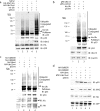Regulation of p53 localization and activity by Ubc13
- PMID: 17000756
- PMCID: PMC1636826
- DOI: 10.1128/MCB.01156-06
Regulation of p53 localization and activity by Ubc13
Abstract
The abundance and activity of p53 are regulated largely by ubiquitin ligases. Here we demonstrate a previously undisclosed regulation of p53 localization and activity by Ubc13, an E2 ubiquitin-conjugating enzyme. While increasing p53 stability, Ubc13 decreases p53 transcriptional activity and increases its localization to the cytoplasm, changes that require its ubiquitin-conjugating activity. Ubc13 elicits K63-dependent ubiquitination of p53, which attenuates Hdm2-induced polyubiquitination of p53. Ubc13 association with p53 requires an intact C-terminal domain of p53 and is markedly stronger with a p53 mutant that cannot tetramerize. Expression of Ubc13 in vivo increases the pool of monomeric p53, indicating that Ubc13 affects tetramerization of p53. Significantly, wild-type but not mutant Ubc13 is associated with polysomes and enriches p53 within this fraction. In response to DNA damage, Ubc13 is no longer capable of facilitating p53 monomerization, in part due to a decrease in its own levels which is p53 dependent. Our findings point to a newly discerned mechanism important in the regulation of p53 organization, localization, and activity by Ubc13.
Figures









References
-
- Ashcroft, M., and K. H. Vousden. 1999. Regulation of p53 stability. Oncogene 18:7637-7643. - PubMed
-
- Brooks, C. L., and W. Gu. 2003. Ubiquitination, phosphorylation and acetylation: the molecular basis for p53 regulation. Curr. Opin. Cell Biol. 15:164-171. - PubMed
-
- Brummelkamp, T. R., R. Bernards, and R. Agami. 2002. Stable suppression of tumorigenicity by virus-mediated RNA interference. Cancer Cell 2:243-247. - PubMed
-
- Brusky, J., Y. Zhu, and W. Xiao. 2000. UBC13, a DNA-damage-inducible gene, is a member of the error-free postreplication repair pathway in Saccharomyces cerevisiae. Curr. Genet. 37:168-174. - PubMed
Publication types
MeSH terms
Substances
Grants and funding
LinkOut - more resources
Full Text Sources
Molecular Biology Databases
Research Materials
Miscellaneous
